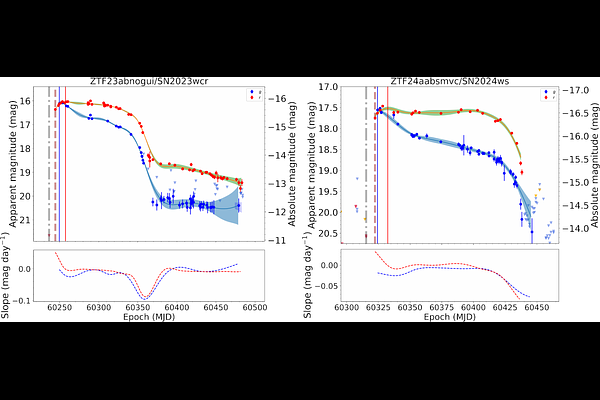Low-Luminosity Type IIP Supernovae from the Zwicky Transient Facility Census of the Local Universe. I: Luminosity Function, Volumetric Rate

Low-Luminosity Type IIP Supernovae from the Zwicky Transient Facility Census of the Local Universe. I: Luminosity Function, Volumetric Rate
Kaustav K. Das, Mansi M. Kasliwal, Christoffer Fremling, Jesper Sollerman, Daniel A. Perley, Kishalay De, Anastasios Tzanidakis, Tawny Sit, Scott Adams, Shreya Anand, Tomas Ahumuda, Igor Andreoni, Sean Brennan, Thomas Brink, Rachel J. Bruch, Ping Chen, Matthew R. Chu, David O. Cook, Sofia Covarrubias, Aishwarya Dahiwale, Nicholas Earley, Anna Y. Q. Ho, Avishay Gal-Yam, Anjasha Gangopadhyay, Erica Hammerstein, K-Ryan Hinds, Viraj Karambelkar, Yihan Kong, S. R. Kulkarni, Theophile Jegou du Laz, Chang Liu, William Meynardie, Adam A. Miller, Guy Nir, Kishore C. Patra, Priscila J. Pessi, R. Michael Rich, Nabeel Rehemtulla, Sam Rose, Ben Rusholme, Steve Schulze, Yashvi Sharma, Avinash Singh, Roger Smith, Robert Stein, Milan Sharma Mandigo-Stoba, Nora L. Strotjohann, Yu-Jing Qin, Jacob Wise, Avery Wold, Lin Yan, Yi Yang, Yuhan Yao, Erez Zimmerman
AbstractWe present the luminosity function and volumetric rate of a sample of Type IIP supernovae (SNe) from the Zwicky Transient Facility Census of the Local Universe survey (CLU). This is the largest sample of Type IIP SNe from a systematic volume-limited survey to-date. The final sample includes 330 Type IIP SNe and 36 low-luminosity Type II (LLIIP) SNe with $M_{\textrm{r,peak}}>-16$ mag, which triples the literature sample of LLIIP SNe. The fraction of LLIIP SNe is $19^{+3}_{-4}\%$ of the total CLU Type IIP SNe population ($8^{+1}_{-2}\%$ of all core-collapse SNe). This implies that while LLIIP SNe likely represent the fate of core-collapse SNe of $8-12$ \Msun\ progenitors, they alone cannot account for the fate of all massive stars in this mass range. To derive an absolute rate, we estimate the ZTF pipeline efficiency as a function of the apparent magnitude and the local surface brightness. We derive a volumetric rate of $(3.9_{-0.4}^{+0.4}) \times 10^{4}\ \textrm{Gpc}^{-3}\ \textrm{yr}^{-1}$ for Type IIP SNe and $(7.3_{-0.6}^{+0.6}) \times 10^{3}\ \textrm{Gpc}^{-3}\ \textrm{yr}^{-1}$ for LLIIP SNe. Now that the rate of LLIIP SNe is robustly derived, the unresolved discrepancy between core-collapse SN rates and star-formation rates cannot be explained by LLIIP SNe alone.